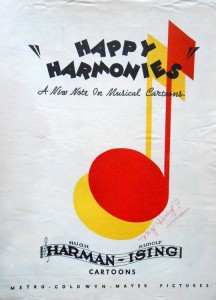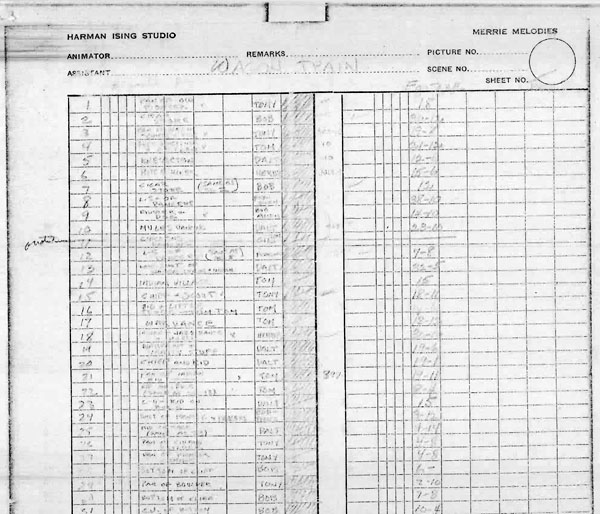
Would you folks like to know how cigar store Indians originated? Find out in this week’s breakdown!
Harman and Ising’s second cartoon for MGM, The Old Pioneer, was the first to bear the name “Happy Harmonies.” (Their first cartoon, The Discontented Canary, was touted as a “Metro Color Cartoon.”) The titular “old pioneer” in this film recounts his travels on the wagon trail to California, which would have occurred almost a century before the film’s release. This film is also more gag-oriented than Harman-Ising’s later cartoons for MGM, where they sought to emulate Disney’s films, emphasizing in charm and spectacle as the Silly Symphonies.
 The ethnic stereotypes of Native Americans, as depicted in Old Pioneer, were a staple in popular entertainment, and this film adheres to familiar clichés, with some unique turns—one Indian warrior redirects his war dance into contemporary jazz steps before reverting back again. In another sequence, as the warriors apply war paint, two Indians hold up mirrors, and fussily apply rouge and lipstick. In the next scene, the Indian chief uses a pencil sharpener to hone the points of his arrows.
The ethnic stereotypes of Native Americans, as depicted in Old Pioneer, were a staple in popular entertainment, and this film adheres to familiar clichés, with some unique turns—one Indian warrior redirects his war dance into contemporary jazz steps before reverting back again. In another sequence, as the warriors apply war paint, two Indians hold up mirrors, and fussily apply rouge and lipstick. In the next scene, the Indian chief uses a pencil sharpener to hone the points of his arrows.
The relationship between the settlers and Indians carry amicable traits—the old pioneer saves a little boy brave in danger of a rolling boulder plummeting down to earth. There are no scenes of the little boy attempting to intervene during the battle (it occurs during near the end of the film instead), and the film reverts to the status quo, with garden-variety “shooting” gags.
Six animators—with four principal artists (Bob Allen, Jim “Tony” Pabian, Tom McKimson and Cal Dalton) responsible for lengthier portions—are credited on Old Pioneer, evident from the developing animation staff for Harman-Ising’s new studio, in contrast to the many animators involved during the cartoons by mid-1935 (for instance, Alias St. Nick). Some of the animation is more advanced, particularly in Pabian’s scenes of the pioneer, but Harman-Ising’s roots from the Schlesinger period still lingered; scene 10, for instance, with the mules dancing to “Chicken Reel” (animated by Dalton) is grounded in that earlier style.
 Francis “Frankie” Smith, one of the cartoon’s key animators, isn’t given much footage in the film. Likewise for an artist credited as “Herby,” which may be animator Herb Rothwell—alternatively spelled as “Rothwill.” Like Cal Dalton, young Rothwell submitted cartoons for the junior cartoonist’s section of the Los Angeles Times — a surviving example from 1927 bears his signature. In between his stint for Harman-Ising, Rothwell animated for Charles Mintz in the early ‘30s, and had returned by the mid-‘30s, working there into the early ‘40s. (He is credited on-screen in 1941’s Tangled Television.) Rothwell later animated for Pantomime Pictures in the ‘60s, working on the toy-sponsored television shows Skyhawks and Hot Wheels.
Francis “Frankie” Smith, one of the cartoon’s key animators, isn’t given much footage in the film. Likewise for an artist credited as “Herby,” which may be animator Herb Rothwell—alternatively spelled as “Rothwill.” Like Cal Dalton, young Rothwell submitted cartoons for the junior cartoonist’s section of the Los Angeles Times — a surviving example from 1927 bears his signature. In between his stint for Harman-Ising, Rothwell animated for Charles Mintz in the early ‘30s, and had returned by the mid-‘30s, working there into the early ‘40s. (He is credited on-screen in 1941’s Tangled Television.) Rothwell later animated for Pantomime Pictures in the ‘60s, working on the toy-sponsored television shows Skyhawks and Hot Wheels.
Like Toyland Broadcast, and assumedly earlier MGM Harman-Ising titles, the draft for The Old Pioneer is written on a “Merrie Melodies” exposure sheet, from the Schlesinger studio. Note the original title of the cartoon is “Wagon Train”.
The credits and descriptions are slightly difficult to read, but each credit is retained in the video. Upon examining the draft, it seemed the artist credited as “Bob” in the draft could have been either Bob Stokes or Bob Allen. Moreover, there are credited scenes assigned to “Bob Allen,” but Stokes’ drawing/animation earmarks aren’t present in The Old Pioneer. The animation looks more comparable to Allen’s work, judging from his work in Toyland Broadcast.
Hopefully, more typewritten MGM drafts from director Rudy Ising’s cartoons exist—maybe the Barney Bears—but time will tell.
Enjoy!


(Thanks to Michael Barrier, Yowp and Frank Young for their help.)


 DEVON BAXTER is a film restoration artist, video editor, and animation researcher/writer currently residing in Pennsylvania. He also hosts a
DEVON BAXTER is a film restoration artist, video editor, and animation researcher/writer currently residing in Pennsylvania. He also hosts a 





















































































I’ve noticed that there’s a scene in The Old Pioneer during the wagon train party hoedown sequence that was recycled into another cartoon (I think it was a Looney Toons/Merrie Melody cartoon) I can’t remember the title of the cartoon.
It’s lifted from the 1932 Merrie Melodie “Moonlight for Two” — the segment with the dancing donkeys starts at 3:22 in that cartoon.
oh, wow…a film i’d never seen. Thank YOU!! These films always amazed me, in that there were only TWO colors in there!!
Holy crap, that print was loaded wtih DVNR! It looked unwatchable. I couldn’t look at the animators credits Devon added!
That’s the 1995 dubbed turner print, that’s why
I’m always impressed with the quality of animation when I see a Happy Harmonies short. The choice of color palette here was also really smart. It’s too bad these didn’t have more exposure over the years and the chances of ever being release on DVD is so remote.
What a coincidence that you chose this cartoon for a breakdown. Yesterday, I was checking out a batch of Terrytoons on YouTube and watched an east coast take on this subject in 1949’s “The Wooden Indian” https://www.youtube.com/watch?v=DjX1yruzPW0
Where Harmon & Ising spoofed the cowboys and Indians cliches, the Terry staff was more sympathetic to the Indians and showed the motivation for the chief’s looney rampage.
Wasn’t this also entitled Ode to a Red Man also animated by Paul Terry and his Terrytoon staff?
It seems that “The Wooden Indian” was a color, nearly scene-for-scene remake of Terry’s 1938 “The Last Indian”. The B&W ending is done as a combined animation with live action traffic. The available print ends abruptly when the car crashes so I’m not sure if it resolves like the color version does.
Oh, this is wonderful to hear such background information on classic HAPPY HARMONIES or MGM cartoons, and I truly hope that more such breakdowns occur. Yes, this particular first run of HAPPY HARMONIES did occasionally feature recycled animation from the LOONEY TUNES or MERRIE MELODIES series, although I must admit they aren’t as much fun as the LOONEY TUNES or MERRIE MELODIES that Harman and Ising created. The animation is golden, as I recall it, though, and yes, this cartoon is indeed gag-oriented with a literal take on “biting the dust”, and I stopped counting how many times the rowdy pioneer spits tobacco! Reused animation does occur, as otehrs have pointed out. In fact, nearly the entire first MGM Bosko cartoon is a teaser, featuring animation from Warner Brothers’ “BATTLING BOSKO”, “BOSKO IN PERSON” and others. Animation and ideas got better and better as the HAPPY HARMONIES series continued, even though they seemed intent on out-Disneying Disney; hey, I saw these cartoons before I ever saw a SILLY SYMPHONY, so I’m partial to the MGM variety, and our station here in New York did air almost all the BOSKO titles in teh series at least once. I wonder if some of teh gags amid the battle sequences might have been recycled for “BOSKO AND THE CANNIBALS”; hmmm, something to research?